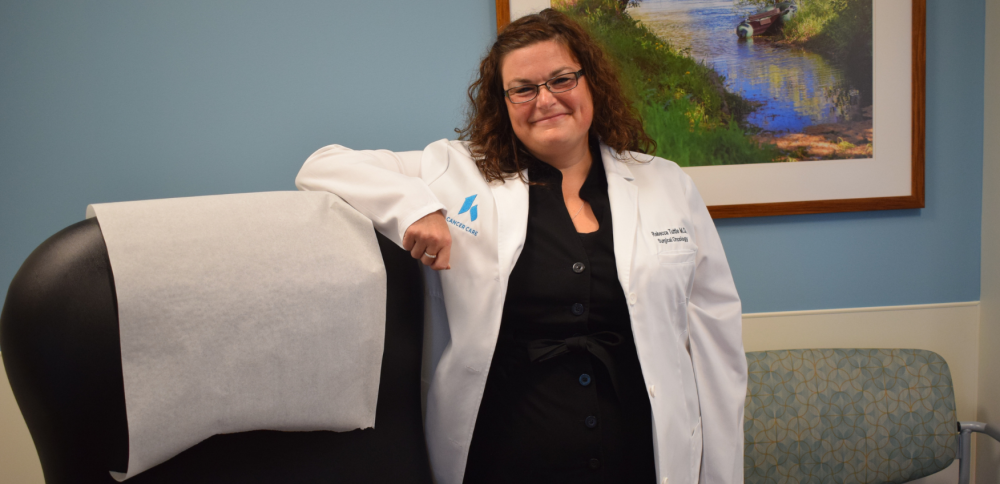Cancer Care
Want to learn more about this at Kettering Health?
With the Fourth of July approaching, many people will be outside enjoying the warmer weather. It’s important to care for your skin in the sun.
Whether you’re swimming at the lake, attending a cookout, or trying for a tan, you’ll likely find yourself in the sun for hours this summer.
Surgical Oncologist Dr. Rebecca Tuttle warns against braving the sun without proper skin protection. She believes you can enjoy a great summer by protecting your skin against its greatest danger from the sun: skin cancer.
What risk does the sun pose?
“Sun exposure is definitively linked to the development of skin cancer. You need to protect yourself when you’re out in the sun,” says Dr. Tuttle.
Developing skin cancer—like melanoma—is associated with lifelong sun exposure. Sunburns increase your risk, particularly severe burns when you’re young, along with your family history and complexion. Those with fair skin, light hair, and light eyes are especially at risk for skin cancer.
Dr. Tuttle recommends practicing sun safety by
- Wearing sunscreen
- Choosing protective clothing
- Staying in the shade when you are outside
The power of sunscreen
Sunscreen is easily the most popular form of sun protection. But with so many options, it’s difficult to know which is best: What brand? Lotion or spray? Which SPF?
Dr. Tuttle says the key is not the SPF number but rather applying sunscreen generously and often.
Wear sunscreen whenever you’re out in the sun, no matter the activity. Stick to SPF 30 since it provides 97% protection from the sun’s rays. And use an ounce of sunscreen—roughly the same amount as a travel-sized hand sanitizer bottle. Reapply every one to two hours and whenever you sweat or swim.
Dr. Tuttle adds, a lesson she learned was to apply sunscreen 15 to 20 minutes before being in the sun for full protection. So, apply sunscreen before leaving the house, not when you arrive to the park or the beach.
Make sure everyone in your group is wearing sunscreen, regardless of activity level or skin tone.
Addressing a sunburn myth
There tends to be a misconception that people of color do not sunburn. But that’s not true; everyone sunburns. It’s just more difficult to see burns on skin with more melanin (the pigment in our skin).
Dr. Tuttle says darker skin does have some natural protection against the sun, but it is crucial to still wear sunscreen.
“The rules still apply,” she says. “People of color are at higher risk for different types of melanoma.”
There are a few signs that indicate a person of color may need to see their doctor for a sunburn.
- Bleeding
- Dark patches
- Patches in nails
- Pigmented spots
- Scabs
Sunburn prevention is skin-cancer protection, for every skin tone. Different options are available, so try different types to find what you need. You can find sunscreen to avoid residue (white cast) or any chemical your body could react differently to.
Sunscreen choices are also available specifically for children, who are at high risk for sunburns that could increase their skin-cancer risk later in their lives.
Protecting your young ones
Children under six months old should avoid sun exposure. If it’s unavoidable, your baby should not wear sunscreen. Instead, dress them in hats and rash guards for protection. You might even consider continuing the use of protective clothing throughout their childhood.
“For my children, I really like the rash guards (swim shirts),” Dr. Tuttle says. “I don’t know if you have ever tried to put sunscreen on a two-year-old, but it is really like trying to apply sunscreen to a water weenie.”
Dr. Tuttle also recommends the no-sting sunscreen.
“If you put it on and it burns their eyes, you’re going to find it hard to get on them again,” she says.
When children are older and ready for sunscreen, Any type is effective if used correctly. Dr. Tuttle recommends cream for the body to know you’re getting full coverage and stick for the face to avoid sunscreen running into your child’s eyes.
Cover all exposed skin including often missed areas such as
- Tops of feet
- Ears
- Back of neck
Teaching your children to wear sunscreen at an early age will benefit them the rest of their lives.
“It is important to build healthy habits. My kids know if they go outside, they’re going to wear sunscreen. It’s a habit,” she says. “Children learn what they live.”
Caring for your skin
Despite taking precautions, we’ve all gotten a sunburn at least once in our lives. For relief you can use aloe, cooling gel, and Tylenol. Do not peel or pop your blisters—these are your body’s band aid.











